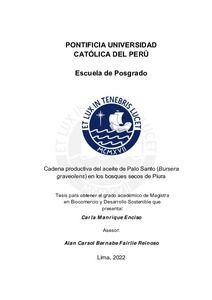Cadena productiva del aceite de Palo Santo (Bursera graveolens) en los bosques secos de Piura
Abstract
Los bosques secos son uno de los ecosistemas más amenazados del
mundo, tienen condiciones climatológicas severas de temperaturas altas y
temporadas prolongadas de sequias, lo que genera que solo algunas especies
muchas veces endémicas puedan habitar en este ecosistema, estas especies
son aprovechadas por familias de bajos recursos que habitan en estos bosques.
Una de las principales especies de los bosques secos es el palo santo, el cual
tiene diversas propiedades medicinales. El palo santo se exporta en diferentes
presentaciones entre las cuales está el aceite esencial que se usa en las
industrias farmacéutica, cosmética, alimentaria y de aromaterapia. El aceite
esencial del palo santo es un producto con valor agregado del Biocomercio que
permite el aprovechamiento de materias primas de manera sostenible.
Esta investigación permite analizar la cadena de valor del aceite de palo
santo en Piura y determinar si tiene actores que cumplen con los principios del
Biocomercio y los enfoques de cadena de valor y ecosistémicos, utilizando la
metodología cualitativa con entrevistas a los principales actores de la cadena y
cuantitativa mediante una búsqueda bibliográfica del comercio del palo santo.
Además, se realizó un análisis de los indicadores de los principios del
Biocomercio con las herramientas FODA y una matriz de cumplimiento.
Se concluye que el modelo de cadena de valor del aceite de palo santo
analizado en este trabajo de investigación cumple con la mayoría de los
principios del Biocomercio, sin embargo, existen otros modelos con puntos
críticos que necesitan ser resueltos para que puedan cumplir con estos
principios. Dry forests have an ecosystem that is rich in biological resources, they are
one of the most threatened ecosystems in the world, they have severe weather
conditions that are resistant to high temperatures and prolonged drought
seasons, which means that only some often endemic species can inhabit in this
ecosystem droughts, making them an ecosystem possibly resistant to climate
change, in addition, which these species are used by several low-resource
families, their resources are used by several families that inhabit these low resource forests. One of the main species of dry forests is the Palo Santo, which
has various medicinal properties. Palo santo is exported in different
presentations, among which is the essential oil used in the pharmaceutical,
cosmetic, food and aromatherapy industries. The essential oil of palo santo is a
product with added value from BioTrade with added value that allows the use of
raw materials in a sustainable way.
This research makes it possible to analyze the Palo Santo oil value chain
in Piura and determine if it has actors that comply with the BioTrade principles
and the value chain and ecosystem approaches, using the qualitative
methodology with interviews with the main actors in the chain. and quantitative
through a bibliographic search of the palo santo trade. In addition, an analysis of
the indicators of BioTrade principles was carried out with the SWOT tools and a
compliance matrix.
It is concluded that the value chain model of palo santo oil analyzed in
this research work complies with most of the principles of Biotrade, however,
there are other models with critical points that need to be resolved so that they
can accomplish with these principles.
Temas
Bosques--Perú--Piura
Vegetación y clima--Perú--Piura
Diversidad biológica--Perú--Aspectos económicos
Plantas medicinales y aromáticas--Industria y comercio
Vegetación y clima--Perú--Piura
Diversidad biológica--Perú--Aspectos económicos
Plantas medicinales y aromáticas--Industria y comercio
Para optar el título de
Magíster en Biocomercio y Desarrollo Sostenible
Collections
The following license files are associated with this item:






